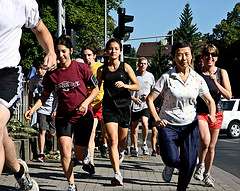Beating depression with exercise

Having trouble sticking to your new year’s resolution to hit the gym three times a week? What if you knew that exercising could stave off Alzheimer’s? What if your motivations weren’t about just about improving your body but about improving your mind?
University of Toronto's Jenny Hall spoke with Professor Guy Faulkner of the Faculty of Physical Education and Health about the mental health benefits of exercise.
Is exercise is good for mental health?
Yes. The physical health benefits of being more active are beyond dispute. But there are mental health benefits as well. Physical activity can promote mental health for the general population. Evidence is also there for exercise as an effective anti-depressant for people with depression. And there’s evidence that being physically active actually prevents mental illness—there’s emerging evidence from large epidemiological studies that people who are physically active at one point in time are less likely to experience mental illness later. So there’s a protective mechanism at work.
Would this include dementia associated with aging?
Yes. Part of the literature looks at that question and physical activity does seem to have a protective affect in terms of delaying the onset of those illnesses.
What about the general population? What mental health benefits does exercise have?
Researchers have looked at emotions and mood, and consistently demonstrated that even short bouts of physical activity, such as walking, make people feel good. Researchers have also looked at things like sleep quality and quantity and physical activity has been shown to help people better sleep better and longer. Physical activity also makes us feel better about ourselves physically and that can lead to improved global feelings of self esteem.
How does this work? Why do we see these positive outcomes when we exercise?
For some people it may just be the distraction. Going out for a run provides a temporary break from the stresses of the work day. For others, it’s a sense of competence and mastery and learning a new skill. There may be a biochemical mechanism operating in some people—sometimes called a runner’s high—but this is only associated with more intense exercise. The runner’s high is rare for the general population.
There are a range of potential mechanisms at work. It’s likely that there is a complex unique formula that operates for each person. But in our research we see mental health benefits even with quite modest doses of physical activity.
Can you tell us some more about your research?
We are looking at short-term changes in how people feel in response to different doses of physical activity. When we’re recommending a new exercise program to someone who is inactive, we’re interested in whether a short walk can have an impact on how you feel. We look at 10-minute bouts of light to moderate walking—we ask people to walk as if they’re late for a meeting. Doing this creates significant changes in how people feel.
We’ve also extended this research to smokers who are trying to quit. Cravings and withdrawal symptoms are associated with relapse, so we use short bouts of physical activity as an emotion regulation strategy. We have found significant benefits.
Is it too crude to say that exercise makes people happier?
Not at all. I’d clarify the statement by suggesting that for some people what is important is the process of exercising rather than the exercise per se – for example, interacting with other people, improving skills, or feeling a sense of control over what one’s body can do – these experiences might contribute to feelings of well-being.
Why is it so hard for so many people to get started or to maintain an exercise routine?
We know that exercise makes people feel good. We need to link that feeling to people going back and exercising day in and day out.
We need to move beyond just saying “you should exercise” and toward helping people develop the skills necessary to start and maintain an exercise program.
What are those skills?
It’s about developing self-regulatory skills. There are three in particular that we think are important.
One is self monitoring. People need to learn how to assess and monitor their activity levels. Without that they don’t necessarily know whether they’re succeeding, and there’s no basis to set goals, which we know are important for motivation.
The second skill is action planning, getting people to schedule when they’re going to be active and really look at when and with whom, If you just say, “oh, yeah, I’m going to be more active,” it doesn’t work. You need to commit to it, put it in your diary, and make plans to meet up with a friend.
The final skill is confidence to overcome barriers. We help people identify the barriers they face and then help them problem solve strategies to overcome them.
The key message here is that physical activity is a complex health behavior to initiate and maintain and it requires a level of self-regulatory skill to carry off.
You don’t have to go to the gym to be active, though, right??
For some people the gym is never going to be the answer. There are alternatives that don’t involve going to a spin class. Walking is a good example. We try to encourage greater walking, of a moderate intensity (physical activity that makes you breath a bit harder, makes you feel warm)throughout the day, whether it’s the commute to and from work, talking to a colleague instead of sending an e-mail, taking the stairs instead of an elevator. The evidence suggests that there are physical and psychological benefits from this kind of activity.
You really can’t lose by trying to integrate more physical activity into your day. As researchers, we’ve looked at how physical activity adds years to life, but the flip side of this is that physical activity also adds life to years.










.jpg)







